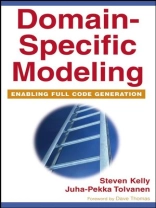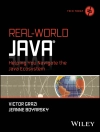‘[The authors] are pioneers. . . . Few in our industry have their
breadth of knowledge and experience.’
–From the Foreword by Dave Thomas, Bedarra Labs
Domain-Specific Modeling (DSM) is the latest approach to
software development, promising to greatly increase the speed and
ease of software creation. Early adopters of DSM have been enjoying
productivity increases of 500-1000% in production for over a
decade. This book introduces DSM and offers examples from various
fields to illustrate to experienced developers how DSM can improve
software development in their teams.
Two authorities in the field explain what DSM is, why it works,
and how to successfully create and use a DSM solution to improve
productivity and quality. Divided into four parts, the book covers:
background and motivation; fundamentals; in-depth examples; and
creating DSM solutions. There is an emphasis throughout the book on
practical guidelines for implementing DSM, including how to
identify the necessary language constructs, how to generate full
code from models, and how to provide tool support for a new DSM
language. The example cases described in the book are available the
book’s Website, www.dsmbook.com, along with, an evaluation copy of
the Meta Edit+ tool (for Windows, Mac OS X, and Linux), which allows
readers to examine and try out the modeling languages and code
generators.
Domain-Specific Modeling is an essential reference for lead
developers, software engineers, architects, methodologists, and
technical managers who want to learn how to create a DSM solution
and successfully put it into practice.
Cuprins
Foreword.
Preface.
PART 1: BACKGROUND AND MOTIVATION.
1. Introduction.
1.1 Seeking the better level of abstraction.
1.2 Code-driven and model-driven development.
1.3 An example: modeling with a general-purpose language and with a domain-specific language.
1.4 What is DSM?
1.5 When to use DSM?
1.6 Summary.
2. Business value.
2.1 Productivity.
2.2 Quality.
2.3 Leverage expertise.
2.4 The economics of DSM.
2.5 Summary.
PART 2: FUNDAMENTALS.
3. DSM defined.
3.1 DSM characteristics.
3.2 Implications of DSM for users.
3.3 Difference to other modeling approaches.
3.4 Tooling for DSM.
3.5 Summary.
4. Architecture of DSM.
4.1 Introduction.
4.2 Language.
4.3 Models.
4.4 Code generator.
4.5 Domain framework and target environment.
4.6 DSM organization and process.
4.7 Summary.
PART 3: DSM EXAMPLES.
5. IP telephony and call processing.
5.1 Introduction and objectives.
5.2 Development process.
5.3 Language for modeling call processing services.
5.4 Modeling IP telephony service.
5.5 Generator for XML.
5.6 Framework support.
5.7 Main results.
5.8 Summary.
6. Insurance products.
6.1 Introduction and objectives.
6.2 Development process.
6.3 Language for modeling insurances.
6.4 Modeling insurance products.
6.5 Generator for Java.
6.6 Framework support.
6.7 Main results.
6.8 Summary.
7. Home Automation.
7.1 Introduction and objectives.
7.2 Development process.
7.3 Home automation modeling language.
7.4 Home automation modeling language in use.
7.5 Generator.
7.6 Main results.
7.7 Summary.
8. Mobile phone applications using Python framework.
8.1 Introduction and objectives.
8.2 Development process.
8.3 Language for application modeling.
8.4 Modeling phone applications.
8.5 Generator for Python.
8.6 Framework support.
8.7 Main results.
8.8 Extending the solution to native S60 C++.
8.9 Summary.
9. Digital Wristwatch.
9.1 Introduction and Objectives.
9.2 Development Process.
9.3 Modeling Language.
9.4 Models.
9.5 Code Generation for Watch Models.
9.6 The Domain Framework.
9.7 Main Results.
9.8 Summary.
PART 4: CREATING DSM SOLUTIONS.
10 DSM language definition.
10.1 Introduction and objectives.
10.2 Identifying and defining modeling concepts.
10.3 Formalizing languages with metamodeling.
10.4 Defining language rules.
10.5 Integrating multiple languages.
10.6 Notation for the language.
10.7 Testing the languages.
10.8 Maintaining the languages.
10.9 Summary.
11. Generator definition.
11.1 ‘Here’s one I made earlier’.
11.2 Types of generator facilities.
11.3 Generator output patterns.
11.4 Generator structure.
11.5 Process.
11.6 Summary.
12. Domain Framework.
12.1 Removing duplication from generated code.
12.2 Hiding platform details.
12.3 Providing an interface for the generator.
12.4 Summary.
13. DSM definition process.
13.1 Choosing among possible candidate domains.
13.2 Organizing for DSM.
13.3 Proof of concept.
13.4 Defining the DSM solution.
13.5 Pilot project.
13.6 DSM deployment.
13.7 DSM as a continuous process in the real world.
13.8 Summary.
14. Tools for DSM.
14.1 Different approaches to building tool support.
14.2 A Brief History of Tools.
14.3 What is needed in a DSM environment.
14.4 Current tools.
14.5 Summary.
15. DSM in use.
15.1 Model reuse.
15.2 Model sharing and splitting.
15.3 Model versioning.
15.4 Summary.
16. Conclusion.
16.1 No sweat shops–But no Fritz Lang’s Metropolis either.
16.2 The onward march of DSM.
Appendix A: Metamodeling Language.
References.
Index.
Despre autor
Steven Kelly, Ph D, is the CTO of Meta Case and cofounder of
the DSM Forum. He has over fifteen years of experience in building
metamodeling environments and acting as a consultant on their use
in DSM. As architect and lead developer of Meta Edit+, Meta Case’s
DSM tool, he has seen it win or become a finalist for awards from
Byte, SD Times, the Innosuomi Prize for innovation awarded by the
Finnish president, and the Jolt Excellence Awards. Ever-present on
the OOPSLA DSM workshop program committee, he co-organized the
first workshop in 2001.
Juha-Pekka Tolvanen, Ph D, is the CEO of Meta Case. He has
been involved in model-driven approaches, metamodeling, and DSM
languages and tools since 1991. He has acted as a consultant
worldwide on modeling language development and has written over
sixty articles for software development magazines and conferences.
Dr. Tolvanen started the OOPSLA workshops on DSM in 2001 and has
been on the organizing committee since. As cofounder of the DSM
Forum, he plays a leading role in the shift toward model-driven
software development.












